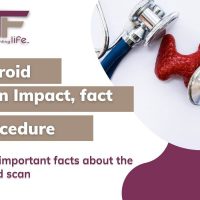If your doctor has also recommended that your endometrium be thickened to prepare for IVF, you’ve come to the perfect place. You’ll find all the details you need to know about IVF right here.
Don’t be concerned if you are unaware of the situation or have no information or knowledge about it. This page has compiled all of the necessary information and will answer all of your questions.
CContents
What is the definition of the endometrium?
The thin line of the uterus is referred to as endometrium. During a person’s reproductive years, however, one organ of the body changes size every month.
During your menstrual cycle, your body prepares to host an embryo, and the thickness of your endometrium may raise or decrease as a result. Furthermore, estrogen and progesterone are the two hormones that initiate the endometrial growth cycle; if the pregnancy does not occur, Shedd will be obtained during menstruation.
Is it simply a standard thickness?
The natural thickness will develop throughout your life. It begins in childhood and continues through sexual maturity, fertile years, and menopause.
The endometrium occurs in young girls who have not yet experienced menstruation, but it is much smaller than it will be later in life. The endometrium is thinnest during the menstruation cycle, measuring between 2 and 4 mm in thickness.
Between the end of one menstrual cycle and the commencement of the proliferative phase, which begins on the 6th or 14th day of your process.
This phase thickens and measures roughly 5-7mm after the bleeding ceases and the stage before ovulation ends. Furthermore, as the cycle progresses and ovulation approaches, the endometrium thickens up to 11mm. Hormones stimulate the release of the egg throughout the first 14 days of a person’s life. Endometrial thickness might reach 16 mm during the secretory phase.
What is the minimum thickness of the uterine lining?
During your IVF cycle, an ultrasound scan will be used to check the thickness of your endometrium. The optimum possible nurturing environment for the embryo is a uterine lining of 9mm or higher for IVF.
The Reasons for a Thin Uterine Lining
A thin uterine lining can lead to implantation issues, which can preclude conception. There are several reasons for thin lining, including:
- Estrogen deficiency.
- There is a lack of blood flow in the uterus.
- Fibroids in the uterus are a type of uterine fibroids.
- Endometrial cells that have been infected.
The uterine lining can become thin for a variety of causes. Before becoming pregnant, you must address a unique anatomical condition that can result in thin endometrium.
Endometriosis also has an evident influence on the ovaries. The egg travels from the ovary to the uterus via the fallopian tube before implantation. Because of the tissues, the egg cannot go to the uterus in the case of endometriosis, so conception is impossible.
Even if the egg makes it to the uterus, endometriosis can harm the eggs as well as a man’s sperm.
This damage occurs as a result of the body’s production of chemicals. It produces further inflammation in the body until doctors discover the exact cause of its emergence. It is possible to become pregnant with a uterine thickness of seven to eight millimeters, but this is dangerous and can lead to subsequent pregnancy failure. As a result, gynaecologists advise that the uterine lining be improved before the embryo transfer process.
Thickening of the uterine lining in preparation for IVF
Begin with your eating habits
If the uterine lining is less than 7mm thick, the doctor will strongly advise that the endometrium be thickened before embryo transfer.
Diet is a great place to start. Dark leafy greens, healthy fats like olive oil, raw almonds, avocado, and grass-fed meats should be included. These foods may aid in the improvement of blood flow while also supplying essential vitamins and minerals.
Take some supplements that will aid you.
The doctor may prescribe estrogen patches, suppositories, or oral pills. Increasing estrogen levels may help the uterine lining improve over time.
Supplements such as iron, digestive enzymes, fish oils, and vitamin E might also be beneficial. L-Arginine, turmeric, and even low-dose aspirin have been shown to benefit in some trials. For high-quality supplements and to avoid harmful combinations, consult a pharmacist.
Regular yet moderate exercise is recommended.
Exercise is one of the most effective strategies to increase blood flow to the uterus. Mild to moderate movement of 20-30 minutes each day is beneficial to fertility. Walking, dancing, yoga, Tai Chi, Qi Gong, and other activities are available. Excessive exercise can have the opposite effect on fertility, so don’t overdo it.
Your uterus should be warmed up
Is it possible to enhance the uterine lining by keeping the uterus warm? A warm uterus could be the key to a healthier lining. The purpose is to improve blood flow, which may aid in the treatment of uterine thickening.
To begin, use a heating pad or a hot water bottle to deliver heat to the lower abdomen. At home, keep your feet warm by wearing socks, shoes, and soft slippers. Don’t be frightened to consume and eat warm beverages.
Treatments to thicken your uterine lining in preparation for IVF
A supplemental course of estrogen medication to strengthen your endometrium may be recommended by your doctor. This is commonly administered as pills, patches, or suppositories. Gonal-F therapy is an alternative that encourages your body to produce more estrogen on its own.
For a healthy embryo, a healthy uterine lining is essential.
In IVF, a healthy, thick uterine lining can make all the difference. These steps can assist in improving the uterus’ overall health. A doctor, on the other hand, would not be able to say how much.
It is possible to conceive with an endometrial lining that is less than 7mm thick. The success rates, however, are lower. If the doctor believes the patient has exhausted all other options without success, IVF will be considered. Please feel free to discuss any concerns with a fertility professional about the health of the uterine lining.
Conclusion
Various natural methods are available that can help to thicken the uterine lining for IVF. It is essential to take care of your eating habits, take the supplements that aid you. Moreover, your embryo must be warmed up, and more. doctors may prescribe you estrogen patches, suppositories, or oral pills, etc. Hopefully, you find this article informative and valuable at the same time.










Comments